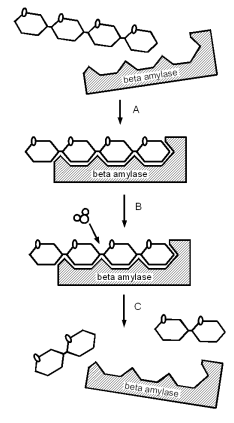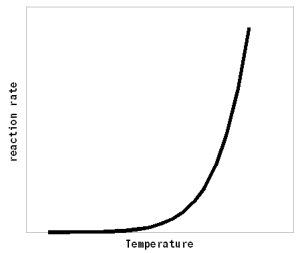Difference between revisions of "The Science of Mashing"
(→Enzymes) |
(→Enzymes) |
||
| Line 37: | Line 37: | ||
| − | As mentioned earlier. Enzymes are generally very specific in the type of substrate they work on and which reaction they catalyze. A simple model for that behavior is the lock-and-key hypothesis [rsc.org]. | + | As mentioned earlier. Enzymes are generally very specific in the type of substrate they work on and which reaction they catalyze. A simple model for that behavior is the lock-and-key hypothesis [rsc.org]. In that theory, the enzyme has a shape that fits only a particular substrate. Like the beta amylase which fits only on the non reducing end of a starch chain (Figure 1). If the shape of the enzyme changes significantly due to temperature or pH or inhibitors block the receptor site of the enzyme it cannot react with the substrate and the enzyme becomes inactive. |
| + | ==How temperature effects enzymatic reactions== | ||
| + | [[Image:Enzyme_reaction_rate.gif|frame|right|Figure 2 - The rate of enzymatic reaction increases exponentially as the temperature is increased]] | ||
| + | The rate of most chemical reactions, including enzymatic reactions, follows the Arrhenius equation [wikipedia.org]: | ||
| − | * what is an enzyme? | + | :'''reaction rate = A * e<sup>(-ΔG*/RT)</sup>''' |
| − | * structure of an enzyme | + | |
| − | * how does it work | + | Where A is the Arrhenius constant. This is simply a non exponential factor for the reaction rate. ΔG* is the activation energy of the reaction and determines at what temperature the reaction will become "significant". R is the universal gas constant and T is the absolute temperature in Kelvin. To convert a temperature in Celsius into Kelvin 273.15 needs to be added to the Celsius value. The absolute temperature (0 Kelvin) is -273.15 Celsius. But all that doesn't really matter. What matters is that the reaction rate of an enzymatic reaction follows an exponential curve (Figure 2). For every 10 C (18F) increase the reaction rate increases 1.2 - 2.5 fold [lsbu.ac.uk]. |
| + | |||
| + | |||
| + | |||
| + | |||
| + | |||
| + | * (X) what is an enzyme? | ||
| + | * (X) structure of an enzyme | ||
| + | * (X) how does it work | ||
* temperature affects on enzymes | * temperature affects on enzymes | ||
* idealized model for enzymatic activity | * idealized model for enzymatic activity | ||
* optimum temperature vs. time | * optimum temperature vs. time | ||
| + | * pH | ||
* [http://www.rsc.org/education/teachers/learnnet/cfb/enzymes.htm] | * [http://www.rsc.org/education/teachers/learnnet/cfb/enzymes.htm] | ||
| Line 55: | Line 67: | ||
| − | [rsc.org] [http://www.rsc.org/education/teachers/learnnet/cfb/enzymes.htm Chemistry for Biologists - How enzymes work] | + | |
| + | : [rsc.org] [http://www.rsc.org/education/teachers/learnnet/cfb/enzymes.htm Chemistry for Biologists - How enzymes work] | ||
| + | : [lsbu.ac.uk] [http://www.lsbu.ac.uk/biology/enztech/temperature.html The effect of temperature on enzymes], London Southbank University | ||
| + | : [wikipedia.org] [http://en.wikipedia.org/wiki/Arrhenius_equation Arrhenius Equation] | ||
=Starch= | =Starch= | ||
Revision as of 05:44, 26 November 2008
------------- Work in progress ------------
In mashing the milled grain (grist) is mixed with water to create the mash. It is an essential process in the production of beer and a continuation of the malting process on the way to sweet wort. During the mash soluble malt compounds like enzymes, proteins and sugars are dissolved by the mash water and insoluble malt compounds like starch and some long chained proteins are converted into soluble compounds and dissolved into the water. The latter happens through a combination of physical and biochemical process which can be controlled by the brewer to achieve a sweet wort of desired quality. The biochemical processes are catalyzed by various malt enzymes. Their function and behavior is dependent on the conditions in the mash (e.g. temperature, pH, concentration, etc.) and the brewer should be familiar with that behavior in order to control the quality of the sweet wort that is run off from the mash in the lautering process.
Contents
Enzymes
Enzymes are very important to mashing. They catalyze conversion reactions which break down malt compounds (the largest one being starch). In the case of starch this conversion is necessary to form water soluble dextrines and sugars. The latter of which can be metabolized by the yeast. Enzymes are proteins (chains of amino acids) which have the ability to lower the energy needed for a chemical chemical reaction which allows that reaction to occur faster and at lower temperatures. Most enzymes are very specific to the reaction they catalyze and work only with a specific substrate and produce only a specific product. In case of the beta amylase enzyme, for example, the substrate is a glucose chain and the product is maltose. The reaction that is catalyzed the the split of a glucose chain link while a molecule of water is consumed. The highly specific nature to the reaction that is catalyzes stems form the shape of the enzyme which is just right for reacting with the substrate and releasing the product and residual product shortly after. The enzyme itself is not consumed in the reaction. I.e. once free again it can catalyze another reaction.

Without an enzyme a chemical reaction may look like this [rsc.org]:
- substrate1 + substrate2 -> product
But the initial energy (i.e. temperature) needed for this reaction may be so high that it rarely ever happens. With the presence of an enzyme this reaction changes to
- substrate1 + enzyme -> enzyme-substrate-intermediate
- enzyme-substrate-intermediate + substrate2 -> product + enzyme
The energy needed for these enzymatic reactions are now low enough for the reaction to happen at practical temperatures (e.g. mash temperatures).
Here is an eample of an actual enzymatic reaction in the mash. The enzyme is maltase which can split a maltose molecule into two glucose molecules. The reaction consumes one water molecule:
- C12H22O11 + H2O -> 2 C6H12O6
With the enzyme maltase the reaction is actually 2 reactions:
- C12H22O11 + <Maltase> -> C12H22O11-<Maltase>
- C12H22O11-<Maltase> + H2O -> C6H12O6 + <Maltase>
The same is true for other enzymatic reactions in the mash. But for simplicity sake the shorter form of:
- substrate1 + substrate2 -> product
Is also used to show the reaction that is happening. The involvement of the enzyme in this reaction is implied
As mentioned earlier. Enzymes are generally very specific in the type of substrate they work on and which reaction they catalyze. A simple model for that behavior is the lock-and-key hypothesis [rsc.org]. In that theory, the enzyme has a shape that fits only a particular substrate. Like the beta amylase which fits only on the non reducing end of a starch chain (Figure 1). If the shape of the enzyme changes significantly due to temperature or pH or inhibitors block the receptor site of the enzyme it cannot react with the substrate and the enzyme becomes inactive.
How temperature effects enzymatic reactions
The rate of most chemical reactions, including enzymatic reactions, follows the Arrhenius equation [wikipedia.org]:
- reaction rate = A * e(-ΔG*/RT)
Where A is the Arrhenius constant. This is simply a non exponential factor for the reaction rate. ΔG* is the activation energy of the reaction and determines at what temperature the reaction will become "significant". R is the universal gas constant and T is the absolute temperature in Kelvin. To convert a temperature in Celsius into Kelvin 273.15 needs to be added to the Celsius value. The absolute temperature (0 Kelvin) is -273.15 Celsius. But all that doesn't really matter. What matters is that the reaction rate of an enzymatic reaction follows an exponential curve (Figure 2). For every 10 C (18F) increase the reaction rate increases 1.2 - 2.5 fold [lsbu.ac.uk].
- (X) what is an enzyme?
- (X) structure of an enzyme
- (X) how does it work
- temperature affects on enzymes
- idealized model for enzymatic activity
- optimum temperature vs. time
- pH
- [rsc.org] Chemistry for Biologists - How enzymes work
- [lsbu.ac.uk] The effect of temperature on enzymes, London Southbank University
- [wikipedia.org] Arrhenius Equation
Starch
- where it is found
- glucose and 1-4/1-6 branches
- amylose
- amylopectin
- starch granule structure
Starch conversion
- gelatinization
- active enzymes
- emzyme temperature and pH optima
- mash parameters affecting conversion


